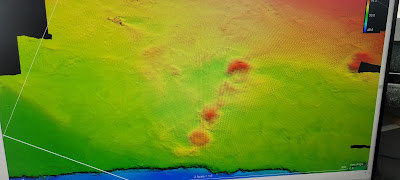 |
| Hurricane Ida uncovered these artillery shells in Florida (Gulf Islands National Seashore) |
We’ve got a few items in the works and we look forward to rolling those and others out in 2022. Thanks so much for your continued interest. Please tell a friend or two about us. Happy New Year!
11. USS MONITOR: The little ironclad that could sported two Dahlgren guns in its famous rotating turret. Conservators at the Mariners’ Museum and Park in Newport News, Va., were honored this year by the Navy for cleaning their barrels of salts and sediment, keeping them on the path for one day being put on display. -- Read more
10. JAMES LONGSTREET: The Longstreet Society in Gainesville, Ga., acquired a brief but fascinating letter from the legendary Confederate general seeking a federal pension 20 years after the Civil War’s end. Longstreet expressed guarded hope that his valiant service in the U.S. Army in the Mexican-American War would outweigh any concerns about him later donning the gray uniform. -- Read more
9. UNEARTHED BAYONET: An Illinois man tilling a garden came across something way the down the list of possible surprises: A rusted bayonet. Did it belong to a soldier serving in Ulysses S. Grant’s first Civil War command? -- Read more
 |
| The bayonet in its temporary exhibit (Nick Little, Market House Antiques) |
7. MYSTERY COFFIN: We invited you to come read the adventure of one coffin, 20 rifles and two caretakers of Georgia history. And you did. The coffin found at Fort McAllister State Park near Savannah is being conserved and officials might use the same chemical treatment on Enfield rifles (right) that were smuggled into Charleston Harbor but were lost when the blockade runner ran aground. -- Read more
6.
IRONCLAD REMOVAL CONCLUDED: The CSS Georgia,
while woefully underpowered, did its job in Savannah, Ga. It was among a myriad
of stationary defenses that kept Federal forces from sailing into the city
during the Civil War. Federal officials have now wrapped up their removal of
the gunboat’s debris as part of a harbor deepening project. -- Read more
5. CAMP
LAWTON SKIRMISH: Archaeology students at a Georgia university found artifacts
that might derive from a skirmish between Union and Confederate cavalry during
Maj. Gen. William T. Sherman’s March to the Sea. The fighting took place near a
Confederate POW camp that held Union prisoners for several weeks in autumn 1864. -- Read more
 |
| Spencer rifle casing and toe tap with nails (Courtesy Camp Lawton Archaeological Project) |
3. COCKSPUR LIGHTHOUSE: Fort Pulaski National Monument near Savannah, Ga completed a project aimed at protecting the small but resilient lighthouse. The 46-foot structure has endured high tides, hurricanes, waves from ever-growing container ships, vandals and – for a deafening 30 hours – the April 1862 bombardment of Fort Pulaski during the Civil War. -- Read more
2. HUNLEY’S
SHARP-DRESSED SKIPPER: He was dressed more for a night on the town than for a
moonlit submarine journey toward Union vessels blocking Charleston Harbor. Lt.
George Dixon was decked out in a three-piece outfit, mid-calf suede boots and
silver suspender buckles bearing his initials. Conservators have been analyzing
the incredible array of artifacts found inside the submarine since it was
raised two decades ago and are now working on a volume about the doomed crew,
including personal effects such as clothing, buttons and shoes. -- Read more
1. CONFEDERATE “CRIBS”: Archaeologists using sonar to scan the bottom of the Savannah River located the remnants of four underwater obstructions placed by Confederate defenders during the Civil War. Dubbed cribs, the wooden structures held bricks and other debris meant to thwart ships. -- Read more
 |
| Sonar image of four Confederate cribs in Savannah River (USACE, Savannah) |



No comments:
Post a Comment